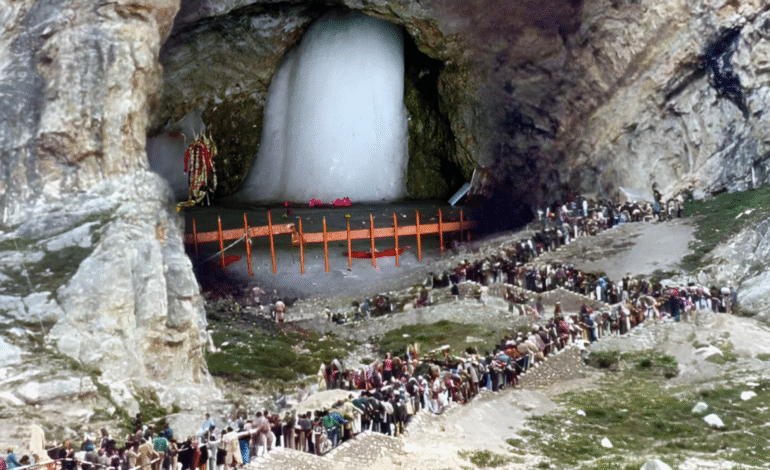Amarnath Yatra 2025 Begins with Devotion, Security, and Innovation

The annual Amarnath Yatra officially began today, marking one of India’s most sacred pilgrimages. Thousands of devotees have already arrived in Kashmir, heading toward the base camps at Pahalgam and Baltal. This year’s yatra promises enhanced safety, advanced technology, and an atmosphere of spiritual unity and communal harmony.
Thousands Arrive Safely in Pahalgam and Baltal Base Camps
The first group of 5,892 registered pilgrims left from the Bhagwati Nagar base camp in Jammu early this morning. They were escorted in a convoy of 310 vehicles, which included 124 buses, 42 medium-sized vehicles, and 144 light vehicles. Among them, 3,403 pilgrims chose the traditional route through Pahalgam in Anantnag, while 2,489 headed for the Baltal route in Ganderbal.
Upon reaching the base camps, the pilgrims received a warm welcome from locals and authorities. Across various districts—Anantnag, Kulgam, Bandipora, and Srinagar—residents, civil society groups, trade associations, and community leaders came together to greet the yatris with flowers, chants, and heartfelt hospitality.
A Display of Kashmir’s Communal Harmony and Hospitality
The welcoming atmosphere reflects the deep-rooted tradition of communal harmony in the Kashmir Valley. Local Muslim communities stood shoulder to shoulder with pilgrims, offering garlands and refreshments as a gesture of peace and respect. This display of togetherness affirms Kashmir’s shared cultural values, despite past tensions.
Many visitors were moved by the warm reception. The participation of the local population showed that faith, culture, and mutual respect can still form powerful bridges of understanding. The administration also played a key role in organizing the reception, ensuring comfort and coordination at every step.
Devotion Overcomes Fear as Faith Prevails
Earlier this year, an attack near Pahalgam raised safety concerns among prospective pilgrims. Authorities acknowledged a temporary 10% dip in registration numbers following the incident. However, recent trends show a rebound in confidence, especially with many choosing the same Pahalgam route despite the past incident.
Pilgrims expressed that their faith was stronger than fear. Several devotees remarked that their spiritual journey could not be deterred by threats, and that belief in Lord Shiva guided them more than any external worry. This emotional strength was echoed across the base camps, where pilgrims stood united in purpose.
Extensive Multi-Layered Security for Pilgrim Safety
To ensure the safety of all participants, the government has deployed a wide network of security personnel. Forces from the Jammu and Kashmir Police, CRPF, Indian Army, BSF, ITBP, SSB, and CISF have been positioned along the entire Yatra route. These security agencies work in close coordination to maintain a high alert status.
From Jammu to the sacred Amarnath Cave, every segment of the journey is being monitored. Checkpoints have been established at key intersections, and patrol units are active in vulnerable areas. The robust deployment reassures pilgrims while maintaining a peaceful environment.
AI Facial Recognition and RFID Tracking for Enhanced Surveillance
For the first time in the history of the Amarnath Yatra, artificial intelligence is being used to enhance safety. Facial recognition systems (FRS) are installed at major entry and exit points. These smart cameras are programmed with data related to individuals under surveillance, such as known offenders or blacklisted persons. If anyone on the list appears in front of an FRS camera, it immediately sends an alert.
Additionally, every registered pilgrim receives an RFID tag. These tags allow authorities to track pilgrim movements in real-time, improving overall management and providing swift responses in case of emergencies. The RFID system is mandatory and has significantly boosted logistical efficiency.
Surveillance, Drones, and Rapid Response Units in Place
In addition to AI and RFID technologies, security personnel are using drones and CCTV cameras for constant surveillance. These tools provide live footage to command centers at both base camps, enabling real-time decisions.
Quick Reaction Teams (QRTs) and bomb disposal squads are stationed throughout the route to handle any potential threats. With this high-tech security network in place, the 2025 Yatra is considered among the most secure pilgrimages in recent years.
Positive Pilgrim Experiences and Emotional Reactions
Many pilgrims arriving at the camps shared that their fears vanished upon seeing the hospitality and security arrangements. One pilgrim said that although they were initially nervous, the sight of flowers, friendly faces, and attentive police officers brought immediate relief.
Others spoke of how emotional the journey felt, not just because of its religious significance, but due to the unexpected warmth from the people of Kashmir. Such positive experiences contribute to the broader narrative of peace and understanding during this sacred event.
Improved Infrastructure and Medical Facilities for Pilgrims
The base camps at Pahalgam and Baltal have been upgraded with modern infrastructure to accommodate the rising number of yatris. Clean drinking water, temporary shelters, proper sanitation, and food stalls have been set up at all major halting points.
Medical aid posts with 24/7 doctor availability, mobile ambulance units, and emergency response centers are ready to serve any pilgrim in distress. In case of altitude sickness, dehydration, or injuries, medical help is available within minutes.
Network coverage has also been improved to allow pilgrims to stay connected with family and officials. Charging stations, wireless communication, and GPS tracking make the journey smoother and safer.
Eco-Friendly Initiatives and Sustainable Waste Management
To protect the fragile Himalayan ecosystem, the administration has introduced eco-friendly measures. Waste disposal units are placed at regular intervals, and plastic usage is being minimized. Biodegradable bags and composting toilets have been installed along the route.
Volunteers and environmentalists are raising awareness about keeping the Yatra clean. Pilgrims are being encouraged to act responsibly and avoid littering, preserving the natural beauty of the region for future generations.
The Spiritual Significance of Amarnath Yatra
The Amarnath Cave Shrine, located at an altitude of 3,888 meters, holds a naturally formed ice Shivling believed to represent Lord Shiva. This annual pilgrimage is one of the most significant in Hinduism and attracts thousands from India and abroad every year.
The journey to the shrine is challenging, requiring physical stamina and mental determination. But for devotees, reaching the cave brings spiritual joy and fulfillment. The pilgrimage is seen as a symbol of faith conquering hardship.
A Collective Effort That Makes the Yatra Possible
Behind the success of the Yatra lies the effort of multiple stakeholders. Government agencies, volunteers, healthcare professionals, transport operators, and locals contribute tirelessly to make this large-scale pilgrimage safe and seamless.
This year, their coordinated efforts have already begun to show results. The first batch of pilgrims is a testament to what is possible when technology, planning, and human compassion come together.
A Journey of Faith, Peace, and Resilience
The 2025 Amarnath Yatra began today with renewed hope and preparation. From high-tech security to heartfelt community support, every aspect of the pilgrimage has been refined. Pilgrims arrive not just with backpacks, but with deep devotion and determination.
As the sacred journey continues in the coming days, thousands more will make their way to the sacred cave. With every step, they are not only taking part in a religious ritual but also reinforcing the timeless values of faith, harmony, and resilience.
The Amarnath Yatra is more than a journey to a shrine—it’s a walk of unity, belief, and the enduring spirit of togetherness in the face of all odds.







